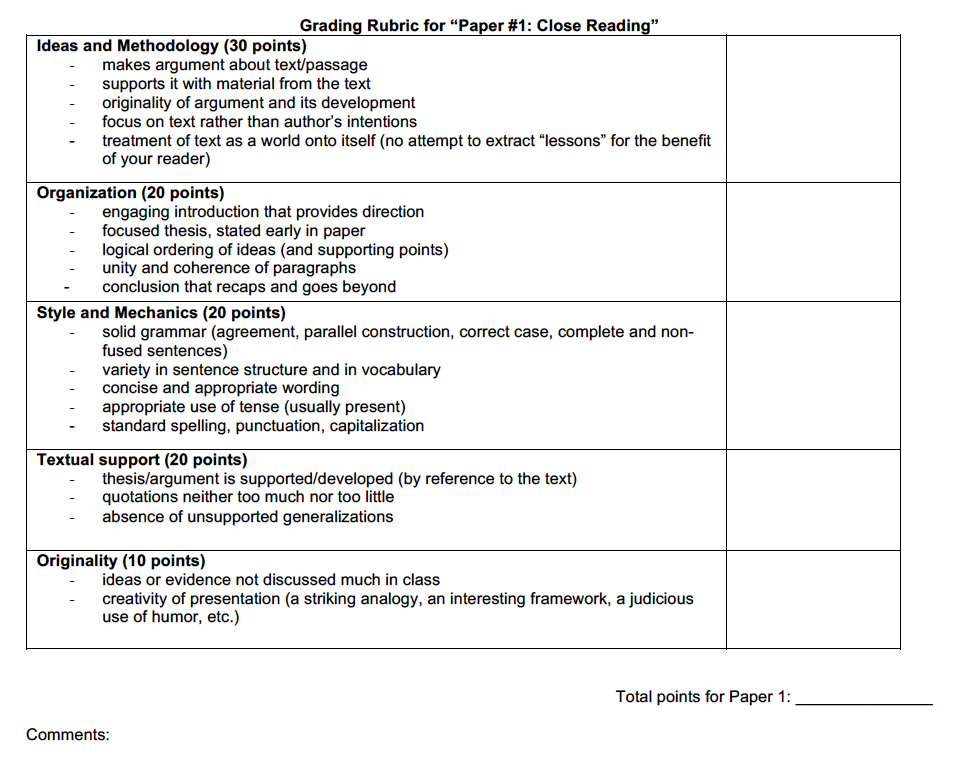Provided by Melissa Azari, Megan Kennedy, and Zachary Rewinski on behalf of Slavic graduate students at UW-Maddison (Department of German, Nordic, and slavic).
Course: Literature in Translation 201 and 203 (19th– and 20th-Century Russian Literature in Translation
Length: 500-750 words, double-spaced, 1-inch margins, 12 point Times New Roman font, stapled.
Due date: Tuesday, September 29 in class
Assignment: Discuss any ONE of the passages from Eugene Onegin listed below:
• Chapter 1, stanzas 45-51 and Chapter 2, 13-17
• Chapter 1, stanzas 8-12 and Chapter 2, stanzas 7-8, 20-22
• Chapter 3, stanzas 6-10, 21-25
• Chapter 6, stanzas 26-35
• Chapter 3, “Tatyana’s Letter” and Chapter 8, “Onegin’s Letter”
• Chapter 4, stanzas 12-16 and Chapter 8, stanzas 42-47
As you prepare to write, treat the passage(s) as a complete, stand-alone text. Read it through a few times, concentrating on all its details. Assume that everything is significant. Look up any words you don’t know. Write down or underline all the details that jump out at you: time, setting, characters, themes, oppositions, etc. Identify and analyze any stylistic elements and literary devices present in the passage. Refer to the literary terms glossary assignment (of course, not all of the devices in that assignment will appear in your passages – focus on the ones that do!).
Next, still before you start writing, consider the role this passage plays in the overall structure and/or meaning of the text: What purpose does it serve? How does it provide insight into the larger text? Does it foreshadow later events? Refer back to earlier ones? Does it provide us with a “key” to the rest of the work? Answering these questions will help you to formulate a good thesis statement.
Finally, try to organize your observations from the above into a focused argument, or thesis. You will need to focus on relevant observations/details that support your thesis, and leave others out. While you cannot talk about everything and there is no one “right” answer, be sure to address the points that best support your argument. You may want to address any passages that could provoke a counter-argument as well.
Do not retell the story; analyze the text. Keep your audience in mind! Assume your readers have read the book and know who Pushkin is. Show them something about the work that they may not necessarily have seen for themselves.
NB For the purposes of this assignment, please use this modified form of parenthetical citation style for all direct quotations: (I.50.1), with the Roman numeral representing a chapter and the Arabic numerals referring to a particular stanza, then line. Because outside sources neither necessary nor desirable for this assignment, a separate bibliography is not required.
GUIDELINES FOR STRUCTURING YOUR ESSAY
TITLE: Come up with a descriptive title (i.e., not just “A Close Reading of Pushkin’s Eugene Onegin”). This may be easier to do once you’ve finished drafting your essay.
INTRODUCTION:
1. Refer to the passage(s) you’ll be discussing, and briefly situate it/them in the work as a whole.
2. Thesis statement: what do you intend to prove? Be specific! It’s not enough to say, “This passage shows characterization.” Instead, say something like, “In this passage, Olga is characterized as pretty but dull.”
3. Supporting details: How do you intend to prove your thesis? What details do you intend to focus on?
THE BODY:
1. Each paragraph in the body of your essay should focus on one particular idea, theme or stylistic element. In the body of your essay, you want to expand on the supporting details (see above) you bring up in your introduction.
2. Be sure to use textual details and quotes to back up your ideas! Quotations are evidence for your thesis. While it is important to present evidence, it is equally important to avoid relying too much on quotations. Only include what is most important for supporting your argument. See the bottom of the other side of the page for how to format quotations in this essay.
3. The order of the supporting details you present does not necessarily need to follow the order in which they appear in the passage(s). Instead, structure your evidence based on how it relates to your central argument.
4. Most importantly, in the body of the essay, stay within the given passage(s) – try not to stray too far into the rest of the text. Try to treat the passage under consideration as a text unto itself. You can use the conclusion to discuss the role the passage(s) play in the novel as a whole.
CONCLUSION:
1. Summarize your argument and how you defended it. Don’t simply restate what you’ve already written, though!
2. Try to relate the passage and your interpretation of it to the rest of the work: how does your reading of this part illuminate the whole?
